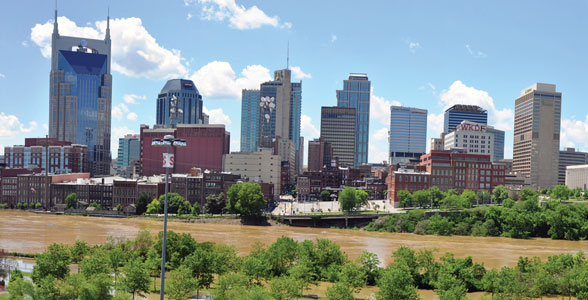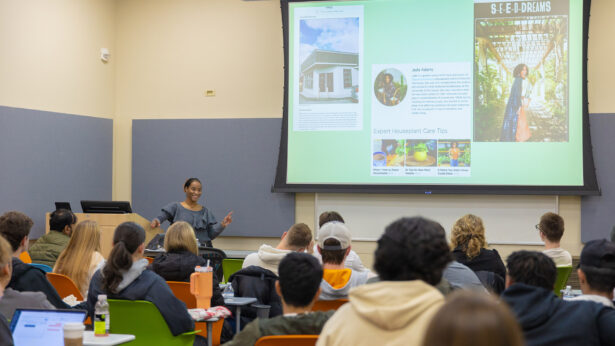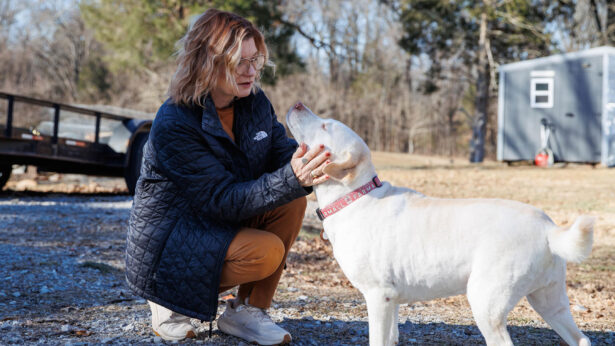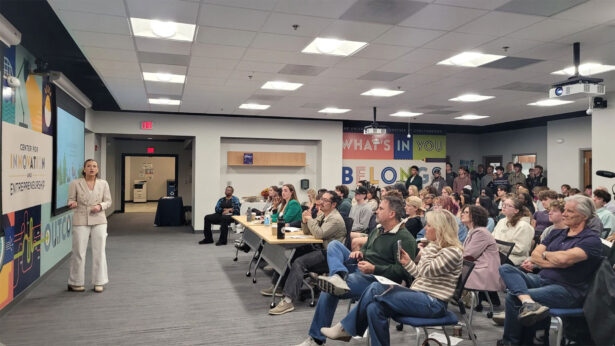By Richard Locker
For most Nashville area residents, May 1, 2010, began as a typical spring Saturday morning except that the rain that started falling about dawn was heavier than a spring shower. It was “raining cats and dogs,” as the older folks used to say, so the usual Saturday errands, shopping, work, or lunch out with friends meant umbrellas and wet feet.
By noon, motorists found it difficult driving on rain-covered streets. But the first signs of serious trouble came in midafternoon when TV stations broke in with live video feeds of tractor-trailer rigs under water to their roofs on Interstate 24, cars floating by them, and their passengers — the lucky ones — struggling in neck-deep water to safety. A portable classroom uprooted from an Antioch school swirled down flooded Mill Creek, crashing into a stalled truck and breaking apart on live television.
Greater Nashville’s worst natural disaster in recorded history was underway.
By dawn Sunday, residents who had waited too long to flee rising waters were being rescued by boat from second-floor windows and rooftops. Two parishioners headed to church in Belle Meade died when their car was swept into Richland Creek, a stream barely noticeable most of the time. TV showed a trio of men awaiting rescue on the roof of a strip shopping center, where a big pickup truck, itself picked up by Richland Creek, slammed into the windows of a glass-fronted store. The rain continued, and every hour brought stunning new TV images of the worsening emergency. Sunday night brought breaking news of an urgent mass evacuation of guests and employees from the sprawling Gaylord Opryland Resort, just before the Cumberland River breached levees and flooded the massive complex. New dramas continued to unfold until the floodwaters finally began receding on Thursday.
The dry wording of the U.S. Army Corps of Engineers report, issued nearly 3 months later, conveyed a hint of the tragedy’s scale: “The Cumberland Basin experienced a 36-hour rainfall event that produced record flooding. The historic rainfall . . . created a large-scale flash flood along the Cumberland and lower Tennessee rivers and their tributaries. The two-day storm was estimated to be far greater than a thousand-year rain event.”
The Cumberland — which stood at 19 feet as Saturday, May 1, dawned — swiftly rose to flood stage, 40 feet, by Sunday morning. It crested at a record 51.86 feet at 6 p.m. Monday and remained above flood stage until midday Thursday.
The Nashville area flooding resulted from a string of tornados and thunderstorms that began in Memphis April 30 and moved through West and Middle Tennessee. The weather — primarily the flood — is officially blamed for 24 deaths in the state, including 11 in the Nashville area. Private property damage and losses in Davidson County alone topped $2 billion. Public property — like a huge Nashville water treatment plant — sustained damages totaling hundreds of millions of dollars. Millington and Centerville were also hard hit by flooding.
In Nashville, the flood damaged 10,940 properties, from the Opryland complex to the gleaming new Schermerhorn Symphony Center, to giant industrial plants, to houses and apartments. Vast swaths of the metro area were under muddy water: Antioch along Mill Creek; Opryland, Downtown, North Nashville and Ashland City along the Cumberland; Belle Meade and West Nashville along Richland Creek; and Bellevue and Franklin along the Harpeth River.
At first glance, the area has recovered — as symbolized by the September 28 re-opening of the Grand Ole Opry House, which had been inundated with 4 feet of Cumberland floodwater that destroyed everything inside except its balcony seating.
But other areas were still in various stages of recovery and rebuilding through autumn. Some residents were still living in RVs or trailers parked in their yards while they slowly rebuilt their homes and lives.
 “In terms of the recovery, we’re on track,” Mayor Karl Dean said. “If you go about most of the city you would say ‘Was there a flood here?’ But there are significant buildings, such as the Symphony and Opry Mills [a large shopping complex where repair work proceeds], and there are lots of people who are not back in their homes yet. The hardest cases are still left, where we have to work through finding ways to get people back in their homes. But that’s going to take time, and we’re not going to be recovered until we’ve gotten as many people as we possibly can back in their homes.”
“In terms of the recovery, we’re on track,” Mayor Karl Dean said. “If you go about most of the city you would say ‘Was there a flood here?’ But there are significant buildings, such as the Symphony and Opry Mills [a large shopping complex where repair work proceeds], and there are lots of people who are not back in their homes yet. The hardest cases are still left, where we have to work through finding ways to get people back in their homes. But that’s going to take time, and we’re not going to be recovered until we’ve gotten as many people as we possibly can back in their homes.”
Opryland Resort was scheduled to reopen in mid-November, but Opry Mills mall was fighting a court battle with its insurance companies over its $200 million in damages and wasn’t expected to reopen until mid- to late 2011. About 3,000 people employed by its nearly 200 retailers lost their jobs.
The Symphony Center — a grand $124-million 197,000-square-foot neoclassical performance hall that opened Downtown in 2006 — was set for a gala reopening New Year’s Eve with a concert by the Nashville Symphony and renowned violinist Itzhak Perlman.
Twenty-four feet of water — an estimated 5 million gallons — entered the building and caused $40 million in damages, including damage to the electrical and mechanical systems and parts of its massive concert organ. (The symphony, like The Grand Ole Opry radio show, maintained its summer and fall schedules at other venues, including a free outdoor concert on Public Square the Friday night of flood week, raising spirits in the city.)
Two of the city’s largest cineplexes were flooded and remain closed, leaving 32 screens — one-third of Nashville’s total — dark.
At the Opry House’s reopening, country music’s biggest stars sang the classic “Will the Circle Be Unbroken” on a stage that includes a 6-foot circle of wood cut from the original Ryman Auditorium stage when the Opry moved to its new home in 1974. The circle was salvaged again as the floodwaters rose.
But as winter arrived, the circle was not unbroken for many Nashvillians who lost their homes or loved ones. United Way of Nashville estimated that as many as 2,375 affected households in need had not connected with resources available to them a full 6 months after the flood.
Mayor Dean launched a new program, “We Are Home,” to help them bridge the gap between private and public funding. He held community meetings to build a long-term recovery plan for the city, and residents were asked to submit their ideas online. The Metro Council approved and funded a buyout of flooded houses in flood zones.
The mayor also announced the Nashville Flood Digital History Project, in which residents, business owners, emergency responders, and others are being interviewed by the public library and community agencies. The finished project, which will feature videos, photographs, and the personal accounts, will be unveiled in June 2011 and posted online, as well as in the library’s permanent archive.
One family was finally able to close its circle after nearly 5 months. Relatives and friends of Danny Tomlinson, 39, had combed the Harpeth’s banks since his car was swept away by the flood. They found his remains September 26, the last day they had planned to search until next spring.
Country music star Garth Brooks held benefit concerts in December to benefit the recovery, his first in Nashville since 1998. “I have watched with great pride how the Volunteer State has pulled together to rise above the damage,” Brooks said.
Tennesseans lived up to their Volunteer nickname during and after the crisis, contributing millions of dollars and thousands of hours of their time helping fellow residents. You’ll see the We Are Nashville! bumper stickers, yard signs, and T-shirts until the last displaced resident is home.
Hands on Nashville: From Rescue to Rebuilding
When muddy water began eddying through homes and businesses, it didn’t take long for helping hands to reach out. Some of the best were from Hands On Nashville, and directing those early volunteer efforts was its executive director, UT social work alumnus Brian Williams. Hands On Nashville used strategic disaster plans to mobilize quickly and help rescue victims, as well as provide food, water, and housing.
“I was at the emergency operations center for eight days,” Williams recalls. “We were also out in the community getting people out and cleaning up.”
 Almost 20,000 Hands On Nashville volunteers donated 77,000 hours of their time to clean up and rebuild during the first 4 months after the flooding. Williams says the long-term effects of the disaster are in some ways worse than the initial damage.
Almost 20,000 Hands On Nashville volunteers donated 77,000 hours of their time to clean up and rebuild during the first 4 months after the flooding. Williams says the long-term effects of the disaster are in some ways worse than the initial damage.
“We saw lots of emotional and financial difficulties. Many of the neighborhoods affected were lower socioeconomic areas, and the flooding exacerbated those people’s situations.”
For 4 months, Hands On Nashville volunteers focused on rebuilding houses in conjunction with another volunteer agency, Rebuilding Together Nashville. The organizations received donations to purchase building materials. They supplied skilled and unskilled labor to rebuild 50 to 75 flood-damaged homes.
Professionally Williams says the experience with the flood taught him how to improve services for future disasters. Personally, he says he was amazed at the swiftness and abundance of the community response to those in need.
“I can’t say I was surprised by the response. Overwhelmed is a better word.”
Founded in 1991, Hands On Nashville is Middle Tennessee’s only volunteer resource center. It’s one of the largest affiliates of the nationwide HandsOn Network.
Recovery: Mixed Blessing for Some
The speed with which Nashville has recovered is admirable. But there’s also a downside to the progress, says Samantha Yeargin (Martin ’05, ’06), who volunteers with Hands On Nashville.
“If you didn’t know the city had flooded, you’d never be able to tell,” she reported late last fall. “That’s a testament to a lot of hard work. At the same time, there are plenty of people still displaced, still in need. Even if they’re back in their homes, there’s new debt and continued anxiety. The appearance of all being well is working against them.”
Yeargin worked on demolition projects for Hands On Nashville following the flood, but her most dramatic duty was pre-flood, when she and her husband, Stephen, joined other Hands On Nashville volunteers to sandbag at Nashville’s MetroCenter. Police officers told the volunteers they were entering the business–residential area in north Nashville at their own risk. If the levee went out, the police told the volunteers, they’d likely go out with it.
“That didn’t stop two hundred-plus people from showing up, lining up, and throwing thirty-pound sandbags up a hill for a few hours,” Samantha Yeargin says. Their efforts paid off — roads in the area flooded, but water didn’t reach any of the buildings.
Stephen Yeargin, also a UT Martin alumnus, wrote on his blog about his experiences as a volunteer cleaning out damaged houses soon after the flood:
“To us, the flood meant trash. Our job was to get as much of the stuff out as quickly as possible before mold set up. But the flood was not just an event that turned belongings into trash. It was something that has forever changed [victims’] lives, mixing hope [into] the tragedy of losing everything. Each box was more than just a soggy stack of old clothes — they were memories that the volunteers could never really connect with, but as vivid as ever for those that called the place home.”
Flood Teaches What’s Truly Important
The flood was a reality check for Caleb Binford. With water creeping up around their home in the Bellevue section of Nashville, he and his wife, Leslie, had to get out in a hurry. They grabbed the things that meant the most to them — wedding photos, diplomas, and their pets. The next time they saw their home, it stood in 4 feet of muddy water.
But Binford (Knoxville ’06) says when he realized all the things the couple had worked for — “the house, TVs, DVD, surround sound, shoes, suits, and designer purses” — were gone, he actually felt a sense of peace. “We saved the things that were truly important.”
 Today the Binfords are back in their house, albeit with less “stuff” than before. Caleb Binford is sales and marketing director with LB Processors. Leslie is a nurse in the neurology intensive care unit at Vanderbilt Medical Center. Fortunately for the Binfords, their house was repaired with the help of flood insurance the couple had balked at having to purchase.
Today the Binfords are back in their house, albeit with less “stuff” than before. Caleb Binford is sales and marketing director with LB Processors. Leslie is a nurse in the neurology intensive care unit at Vanderbilt Medical Center. Fortunately for the Binfords, their house was repaired with the help of flood insurance the couple had balked at having to purchase.
“When we were closing on our house, the bank held up the process because they wanted flood insurance added to the policy,” Binford says. “I was so mad,” but ultimately so glad.
May 2, the day of the flood, Binford says he woke up uncharacteristically early. “I went into the kitchen and found the water about two feet from my back door.” He and Leslie (Knoxville ’08) packed a few belongings in their car as the water began coming into the garage. She headed to higher ground while he stayed behind to help alert and evacuate neighbors.
The only road into the neighborhood was submerged. “Even I-40 was under water,” Binford says. “The guard rails and center median had disappeared. We were stuck on our island.”
Some college friends who lived at the top of the hill took the Binfords in. With the power out, the friends fired up their grill so all the neighbors who had food could come and cook and share. “There was no ‘my food’ or ‘my drink’; it was all ‘our food,’ ” Binford says. “ ‘Take what you need,’ was the resounding response throughout the neighborhood.”
At daybreak, Binford went to see the damage at his home.
“What I saw broke me. I hadn’t cried like this ever in my adult life. I couldn’t contain myself. To this point every decision my wife and I made had been so that if everything hit the fan and we lost our jobs, we would at least have our house. Now here was our home under water.”
After they were rescued from the “island,” Binford had time to reflect. “Even more amazing than the water was the community of Nashville. Before FEMA, the fire department, or the police department showed up, there were people helping people. I am so proud to call myself a Nashvillian.”
The flood, clean up, and rebuilding was an ordeal, Binford says. But he’ll never forget the way the community pulled together. “We’re all here to help each other,” he says. It was a true Tennessee Volunteer experience.
Flooded Business Carries On
Is this any way to run a business — 5 feet under water? Apparently so. Kenny Pipe and Supply, even with its Nashville office submerged and power cut off to all its computers and phones, was up and running — not down and out as a result of the Nashville flood. And today repairs of the Nashville office near LP Field and the Cumberland River are complete, says Anderson Hill (Knoxville ’02), who works in the family business owned by his father-in-law.
“We were able to temporarily relocate our Nashville operations to our Murfreesboro facility while the disaster response team cleaned and completely stripped our building. We established a temporary sales counter in Nashville and utilized office space upstairs that was unaffected by the flood. Our manufacturers and vendors were very supportive, shipping replacement inventory and sending teams to salvage usable material.”
The loss of computer power forced a return to business practices from days gone by with employees “taking orders the old-fashioned way, with pen and paper.” Hill says the Nashville community pulled together during the disaster.
“Our citizens, leaders, and emergency responders could not have handled it better in my mind. Hands On Nashville, which many of our UT alumni are involved with, responded with numerous volunteers to assist in various areas of flood relief. They truly embody the Volunteer Spirit.”
Rising from the Flood
Imagine his surprise when Todd Officer (Knoxville ’96) tuned in to the TV news and saw his office under 7 feet of water. That’s how he discovered that the Nashville flood that devastated his neighborhood (but spared his family’s home) had inundated Officer Insurance Agency, which he co-owns with his dad. The office was in Bellevue, one of the areas hardest hit by the floodwaters.
“I took a canoe to the office the next morning,” he says. “We lost everything — furniture, files, computers.” But Officer Insurance was up and running in 2 hours with the phones forwarded to another location.
“We operated that way for about a week and a half. No client had to wait more than two-and-a-half hours to hear back from us. We handled two hundred and fifty claims in seven days.” When the water receded, employees and friends gutted the office to make way for refurbishing.
In the neighborhood where Officer lives in Franklin, Tennessee, restoration is still going on. He says he was amazed how willing everyone was to pitch in.
“Nobody was sitting back waiting for help. Everybody helped everybody else. Someone set up an aid station at the neighborhood entrance. There was a whiteboard with a list of the damaged houses and what each one needed. I would look at the list and head out to help. Someone from FEMA came to assess our situation and he said, ‘You don’t need us. You people have done this better than we could.’ It made you proud to be part of the effort.”
Officer’s most poignant memory was of helping a nearby family move their possessions to the second floor of their house as water seeped into the rooms below. All the hard work was wasted though, when lightning struck the house later that day. The home went up in flames.
Officer Insurance reopened in its original location at the end of July, but there was no insurance to help pay for the refurbishing. “We didn’t have flood insurance,” Officer says. “We were deemed ‘not high risk.’ ”
By the Numbers
24 – Deaths statewide from the storms and flooding of April 30 to May 6, 2010 (Source: TEMA)
10,000 – Tennesseans displaced by the storms (TEMA)
49 – Number of Tennessee counties designated as disaster areas by President Obama
67,683 – Applicants for individual assistance through FEMA
3,697 – Applicants for business assistance
Richard Locker (Knoxville ’78) is Nashville bureau chief for the Memphis Commercial Appeal.



